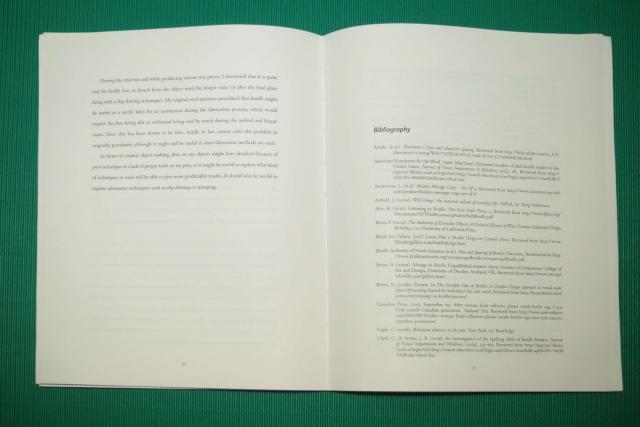Forgot how to make a book
Submitted by Ambrose on Sat, 2016-03-26 01:24
Almost a year after I printed a copy of my thesis (intending to put it on display at GradEx, but shelved the idea when I thought the print shop didn’t print it), I finally took a few hours to gather all the signatures, sew them together, and glue them together into what vaguely looks like a book. It’s still not in book form only because my X-acto is with my box of tools in the studio and I forgot to print the cover.
 Yes, of course this was going to be in the form of a real book, because that’s how all the process books at GradEx look like! :-)
Anyway, while I was doing this, I kept thinking things like “I’ve forgotten what the signature size was”, “I’m supposed to know how to do this”, “too many signatures!” and “I think I did this wrong,” A year after I did the Student Press’s bookbinding workshop I have already forgotten how to sew signatures together.
I still managed to bind the whole thing together. I’m going to get my X-acto back tomorrow and do a layout of a front cover and print it out somewhere… (Hmm… that will have to be printed at 12×18…)
(Oh yeah… and don’t bother to use staplers. Thread and needle is actually easier because you have more control. And awls… they make holes that are too big; I actually like pins better…)
Yes, of course this was going to be in the form of a real book, because that’s how all the process books at GradEx look like! :-)
Anyway, while I was doing this, I kept thinking things like “I’ve forgotten what the signature size was”, “I’m supposed to know how to do this”, “too many signatures!” and “I think I did this wrong,” A year after I did the Student Press’s bookbinding workshop I have already forgotten how to sew signatures together.
I still managed to bind the whole thing together. I’m going to get my X-acto back tomorrow and do a layout of a front cover and print it out somewhere… (Hmm… that will have to be printed at 12×18…)
(Oh yeah… and don’t bother to use staplers. Thread and needle is actually easier because you have more control. And awls… they make holes that are too big; I actually like pins better…)
 Yes, of course this was going to be in the form of a real book, because that’s how all the process books at GradEx look like! :-)
Anyway, while I was doing this, I kept thinking things like “I’ve forgotten what the signature size was”, “I’m supposed to know how to do this”, “too many signatures!” and “I think I did this wrong,” A year after I did the Student Press’s bookbinding workshop I have already forgotten how to sew signatures together.
I still managed to bind the whole thing together. I’m going to get my X-acto back tomorrow and do a layout of a front cover and print it out somewhere… (Hmm… that will have to be printed at 12×18…)
(Oh yeah… and don’t bother to use staplers. Thread and needle is actually easier because you have more control. And awls… they make holes that are too big; I actually like pins better…)
Yes, of course this was going to be in the form of a real book, because that’s how all the process books at GradEx look like! :-)
Anyway, while I was doing this, I kept thinking things like “I’ve forgotten what the signature size was”, “I’m supposed to know how to do this”, “too many signatures!” and “I think I did this wrong,” A year after I did the Student Press’s bookbinding workshop I have already forgotten how to sew signatures together.
I still managed to bind the whole thing together. I’m going to get my X-acto back tomorrow and do a layout of a front cover and print it out somewhere… (Hmm… that will have to be printed at 12×18…)
(Oh yeah… and don’t bother to use staplers. Thread and needle is actually easier because you have more control. And awls… they make holes that are too big; I actually like pins better…)